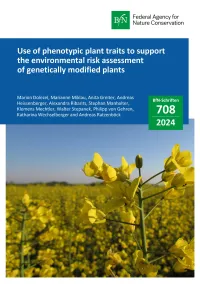BfN-Schriften 708 - Use of phenotypic plant traits to support the environmental risk assessment of genetically modified plants
Formale Aspekte
BfN-Schriften
The aim of this study was to provide suggestions for improvement of methods, parameters and endpoints assessed in agronomic and phenotypic field trials in order to gain conclusive data for use in ERA, specifically with respect to risks related to persistence and invasiveness of the GMP. These risks may become more important in the future if GMPs with tolerance to pathogens or abiotic stress are developed.
Herausgeber*in
Bundesamt für Naturschutz
Publikationsjahr
2024
Heft Nr.
708
Sprache
Englisch
Seiten
218
Beschreibung
In this project, we
- Evaluated and scrutinized the current practice of the agronomic and phenotypic characterisation of GMPs as carried out in GMP applications
- Discussed which phenotypic traits are considered relevant for survival, persistence and invasiveness of plants.
- Outlined environmental harm and protection goals relevant in the context of risks of a GMP to persist, outcross or become invasive.
- Discussed the relevance of Genotype x Environment (GxE) interactions and their assessment in current ERA practice.
- Evaluated methodological approaches for plant phenotyping from different research areas.
- Made recommendations for important GM trait- and plant-specific characteristics with relevance for the agronomic and phenotypic characterisation of GMPs.
- Made recommendations how to improve the agronomic and phenotypic characterisation in general, but also specifically with respect to methodological approaches, in order to achieve relevant data and information that can be used for problem formulation in ERA.
